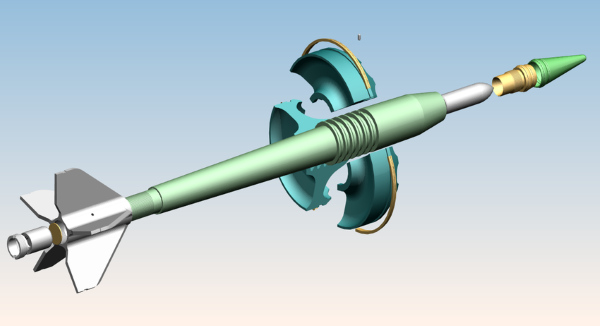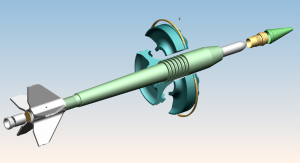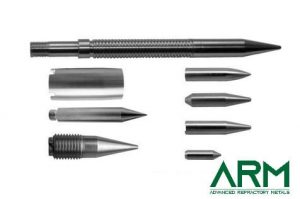Common Materials for Kinetic Energy Penetrator

Understanding Kinetic Energy Penetrator
A Kinetic Energy Penetrator (KEP) is a type of ammunition designed primarily to penetrate heavy armor, such as that found on tanks and fortifications. Unlike explosive munitions, KEPs rely on the kinetic energy generated by their high speed and the density of the materials they are made from to achieve penetration.
 [1]
[1]
- Materials Used: Common materials for KEPs include tungsten and depleted uranium. Tungsten is favored for its hardness and environmental safety, whereas DU offers additional benefits like self-sharpening properties and pyrophoric effects (it ignites upon impact with a target).
- Design: KEPs are typically slender, elongated projectiles that are much heavier and harder than standard ammunition. They often utilize a sabot—a lightweight carrier that falls away after firing—to help them exit the barrel at higher velocities.
- Mechanism: Upon impact, the penetrator's kinetic energy is focused at a small impact area, allowing it to breach armor by sheer force and velocity. The effectiveness of a KEP depends largely on its speed, material properties, and the angle of impact.
- Applications: The primary use of kinetic energy penetrators is in anti-tank roles, where their ability to penetrate thick, advanced armor is critical on the battlefield. They are also used against fortified bunkers and in other military applications where deep penetration through resistant materials is necessary.
Overall, kinetic energy penetrators represent a critical component in modern warfare, providing the capability to defeat enemy armor efficiently and effectively.
Kinetic Energy Penetrator Materials
Below, let’s discuss the primary materials used in kinetic energy penetrators and learn about their key properties and effectiveness.
1. Tungsten

Tungsten is a preferred material for kinetic energy penetrators due to its exceptional density and less environmental impact. First, the high density and hardness make it ideal for penetrating armored vehicles without deformation. It is also less radioactive and toxic compared to DU, making it a safer alternative in terms of environmental and health impacts.
Therefore, tungsten penetrators find use in training and missions in sensitive environments.
Related reading: Tungsten Penetrators: The Cutting Edge Of Armor-Piercing Technology
2. Depleted Uranium (DU)
Depleted uranium is another dense material but with a unique self-sharpening property and pyrophoric nature, which helps it to remain sharp and ignite armor upon penetration. DU penetrator does not blunt as it pierces through armor, making it extraordinarily effective against thick, modern armor. Also, the pyrophoric nature increases the likelihood of igniting ammunition and fuel within the target.
Predominantly used by the US and some NATO countries, its effectiveness is balanced against the potential health risks and environmental toxicity associated with its use.
3. Steel
Steel is significantly cheaper and more widely available. It has decent hardness and density but does not match tungsten or DU in terms of performance. Cost-effectiveness and wide availability make steel a common choice for less demanding applications or where budget constraints are significant.
4. Composite Materials
Composites can include ceramics, carbon fibers, and other advanced materials designed to improve penetration and reduce weight. These materials can be engineered to provide specific properties, such as improved hardness or reduced weight, which can enhance the projectile's velocity and trajectory stability.
5. Osmium and Other Rare Materials
Some experimental penetrators have explored the use of osmium, one of the densest materials available. Theoretically, osmium could provide superior density and mechanical properties. However, its extreme scarcity and high cost limit practical applications.
Future Trends and Innovations
Additionally, in the future:
- Advances in materials science may lead to lighter and harder materials that enhance the penetration capabilities of projectiles, potentially utilizing nanomaterials or novel metal alloys.
- Integrating guidance systems into kinetic energy penetrators could improve their accuracy against moving or distant targets, potentially incorporating laser or GPS guidance to adjust trajectories mid-flight.
- Future developments might include ammunition that can adapt its function based on the target, such as switching between penetration and explosive modes to optimize effectiveness against varied targets.
- Enhanced sensors and targeting technologies could better identify armor weak points and predict target movements, improving the precision and effectiveness of kinetic energy penetrators against mobile adversaries.
The Choice between Tungsten Penetrators and Others
The choice of material for kinetic energy penetrators depends on several factors including desired penetration capabilities, environmental and health considerations, cost, and the technological level of the manufacturing process (See Table 1). Tungsten penetrators and DU penetrators remain the most effective choices for high-performance military applications. Steel and composites offer alternatives for specific scenarios or developmental purposes.
Table 1 Common Material for Kinetic Energy Penetrator
| Material | Notable Features | Applications |
| Tungsten Penetrators | High Density, Low toxicity and radioactivity, | Training, missions in sensitive areas, |
| DU Penetrators | Self-sharpening property, Pyrophoric nature, Yet high toxicity and radioactivity, | Used by the US and some NATO countries, |
| Steel Penetrators | Lower toxicity, Low cost, | Less demanding applications, |
| Composite Materials | Can be engineered for specific properties, | Experimental applications, |
| Osmium and Other Rare Materials | Superior density and mechanical properties, Yet scarcity issues, | Experimental applications, |
Advanced Refractory Metals (ARM) brings two decades of experience in delivering high-performance refractory metals and alloys to a diverse range of industries. We specialize in a wide range of tungsten products, including High-Quality Tungsten Penetrators (W Penetrators) and Custom Materials. To learn more about our products or to request a quote, please check our homepage. We are ready to assist you with any questions you might have about our refractory metal products and how we can support your needs.
Reference:
[1] Hadzihafizovic, Dzevad. (2023). Constriction of rockets, tank ammunition and other ballistic missiles. 10.13140/RG.2.2.18576.79364.
{{item.content}}
LEVE A REPLY
{{item.children[0].content}}
{{item.content}}






